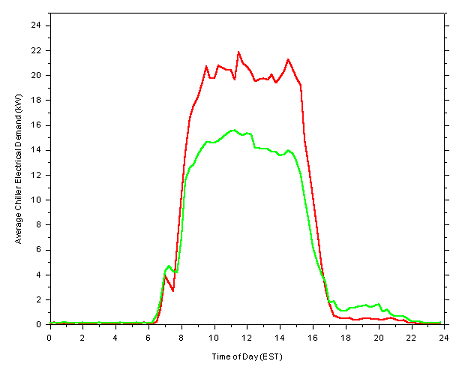
![]()
 Our Saviour's is a private Catholic school built in the 1960's. The building
selected for the study consists of four identical classrooms on the north and
south sides of the building, separated by a12 foot central hallway. The roof
is 12,000 ft2 gray modified bitumen (reflectance= 23%) with 6 foot overhangs
shading the walls and windows from solar heat gain. While the individual classrooms
have controls for the chilled water cooling system, the doors of the classrooms
are often left open to the unconditioned hallway. In addition, the central
hallway's roof/ceiling is uninsulated.
Our Saviour's is a private Catholic school built in the 1960's. The building
selected for the study consists of four identical classrooms on the north and
south sides of the building, separated by a12 foot central hallway. The roof
is 12,000 ft2 gray modified bitumen (reflectance= 23%) with 6 foot overhangs
shading the walls and windows from solar heat gain. While the individual classrooms
have controls for the chilled water cooling system, the doors of the classrooms
are often left open to the unconditioned hallway. In addition, the central
hallway's roof/ceiling is uninsulated.
The air conditioning system consists of two 20-ton air cooled liquid chillers mounted in tandem on the west side of the building. The units have a full load EER of 10.5 Btu/W. The chilled water lines are insulated(R-5), but pass through the building roof plenum prior to dropping down to ceiling mounted air handlers in the classrooms.
The site was fully instrumented including roof surface, decking, attic air, and interior air temperatures. Air chiller power (kWh and kW) and individual classroom air handler power (kWh and kW) is monitored as well as interior relative humidity. A meteorological station was set up to monitor ambient air temperature, relative humidity, and isolation.
Baseline data was collected for a one year period before the re-surfacing took place. A white acrylic compound (reflectance = 68%) with a microbiocide and 25 g of zinc oxide added to prevent microbial growth and therefore degradation of the reflectivity. Total chiller savings at 10% (13,000 kWh) annually were experienced with an average daily demand reduction of 1.5kW.
September space conditioning savings were the greatest in absolute terms at 144 kWh/day (10.3%), while percentage savings were greatest in the shoulder months (March = 28%; November = 35%).

Chiller summer demand profile for weekdays.
Average daily demand
reductions of 1.5 kW were experienced.
Interior classroom temperatures decreased after the roof re-surfacing by an average of 2 oF and the unconditioned hallway temperatures were reduced by an average of 2.5 oF. In spite of this improvement in the interior comfort conditions, the savings during the school day were14.7% (69 kWh/day). Summer weekday utility peak coincident electrical demand of the cooling system was lowered by 5.6 kW -- a 35% reduction over the previous year.
- Full Publication: FSEC-CR-904: Demonstration of Cooling Savings of Light Colored Roof Surfacing in Florida Commercial Buildings: Our Savior's School
